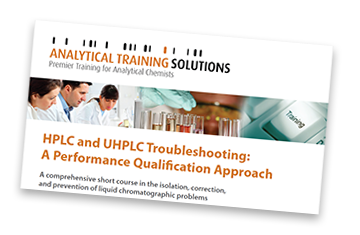 Do you work with HPLC or UHPLC? "HPLC & UHPLC Troubleshooting: A Performance Qualification Approach” is an intensive online course that teaches you the ins and outs of solving problems that occur with your high-performance liquid chromatography (HPLC) and ultra-high pressure liquid chromatography (UHPLC) methods. You will learn how to qualify the performance of your HPLC or UHPLC using specific tests that also can be used for isolating existing problems. More importantly, you’ll learn how to prevent many of these problems from happening in the first place.
Do you work with HPLC or UHPLC? "HPLC & UHPLC Troubleshooting: A Performance Qualification Approach” is an intensive online course that teaches you the ins and outs of solving problems that occur with your high-performance liquid chromatography (HPLC) and ultra-high pressure liquid chromatography (UHPLC) methods. You will learn how to qualify the performance of your HPLC or UHPLC using specific tests that also can be used for isolating existing problems. More importantly, you’ll learn how to prevent many of these problems from happening in the first place.
No previous experience with HPLC or UHPLC systems is assumed; however, much of the course will appeal to the more experienced worker.
In the 'Column Chemistry Problems' section, we'll discuss how to clean a contaminated column and discuss when it is appropriate to wash the column with 100% water. We'll look at the consequences of column dewetting and how the chemistry of the silica and bonded phase play into column lifetime and performance. We'll see how we can use this knowledge to help extend the life of the column, know when it is time to dispose of a column and what causes peak shape changes, fronting, tailing and splitting. We'll learn what the difference is between the right way, the easy way, and the wrong way to make a buffer, and understand when a buffer is effective. We'll explore where those extra peaks in the gradient come from and how we can get rid of them.
In this module on 'Adsorbed Contaminants' you will learn about:
- Why columns fail
- Diagnosing column problems
- Possible symptoms to indicate that sample contaminants have adsorbed on the column
- Why wash with a buffer from the column before washing with a strong solvent
- What happens to the column during 'dewetting' or 'phase collapse'
- Why reverse-flushing the column is a good idea when trying to remove very non-polar contaminants from a reversed-phase column
- Removing contaminants ('column regeneration')
- Finding the source of column contamination
- Avoiding column contamination
- Column protection
This module has a complementary quiz. By correctly answering all of the quiz questions for all of the modules in the 'HPLC and UHPLC Troubleshooting: A Performance Qualification Approach' course you will be able to download your certificate of completion.
By taking this online course you will learn about the operating principles of each module in an HPLC and UHPLC system whilst gaining knowledge of basic HPLC theory as it applies to troubleshooting and instrument maintenance. You will understand why performance qualification (PQ) is so important to ensure the reliable operation of your HPLC and UHPLC and improve the quality of your results. Furthermore, you will learn proven techniques for systematic problem-solving and instrument maintenance and the most effective, time-saving, money saving approaches to preventing common hardware problems and method failures.
The course price is US$ 249 for one user for 12 months of access. Multi-user pricing is also available, as are site licences for larger teams with multiple course requirements.
Analytical Training Solutions, brought to you by Separation Science, is the leading global portal for fundamentals, best practice, troubleshooting and method development training for chromatographic and mass spectrometric techniques. Comprehensive, self-paced online courses and validated learning provides a unique education resource for analytical chemists. Currently we offer HPLC training, LC-MS training, GC training and GC-MS training.
